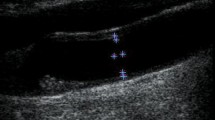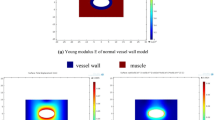Abstract
Clarifying the complex interaction between mechanical and biological processes in healthy and diseased conditions requires constitutive models for arterial walls. In this study, a mathematical model for the displacement of the carotid artery wall in the longitudinal direction is defined providing a satisfactory representation of the axial stress applied to the arterial wall. The proposed model was applied to the carotid artery wall motion estimated from ultrasound image sequences of 10 healthy adults, and the axial stress waveform exerted on the artery wall was extracted. Consecutive ultrasonic images (30 frames per second) of the common carotid artery of 10 healthy subjects (age 44 ± 4 year) were recorded and transferred to a personal computer. Longitudinal displacement and acceleration were extracted from ultrasonic image processing using a block-matching algorithm. Furthermore, images were examined using a maximum gradient algorithm and time rate changes of the internal diameter and intima-media thickness were extracted. Finally, axial stress was estimated using an appropriate constitutive equation for thin-walled tubes. Performance of the proposed model was evaluated using goodness of fit between approximated and measured longitudinal displacement statistics. Values of goodness-of-fit statistics indicated high quality of fit for all investigated subjects with the mean adjusted R-square (0.86 ± 0.08) and root mean squared error (0.08 ± 0.04 mm). According to the results of the present study, maximum and minimum axial stresses exerted on the arterial wall are 1.7 ± 0.6 and −1.5 ± 0.5 kPa, respectively. These results reveal the potential of this technique to provide a new method to assess arterial stress from ultrasound images, overcoming the limitations of the finite element and other simulation techniques.








Similar content being viewed by others
References
Bussy C, Boutouyrie P, Lacolley P, Challande P, Laurent S (2000) Intrinsic stiffness of the carotid arterial wall material in essential hypertensives. Hypertension 35:1049–1054
Chuong CJ, Fung YC (1983) Three dimensional stress distribution in arteries. J Biomech Eng 105:268–274
Cinthio M, Ahlgren AR, Jansson T, Eriksson A, Persson HW, Lindström K (2005) Evaluation of an ultrasonic echo tracking method for measurements of arterial wall movements in two dimensions. IEEE Trans Ultrason Ferroelectr Freq Cont 52:1300–1311
Cinthio M, Ahlgren AR, Bergkvist J, Jansson T, Persson HW, Lindström K (2006) Longitudinal movements and resulting shear strain of the arterial wall. Am J Physiol Heart Circ Physiol 291:394–402
Cox RH (1975) Anisotropic properties of the canine carotid artery in vitro. J Biomech 8:293–300
Cunningham KS, Gotlieb AI (2005) The role of shear stress in the pathogenesis of atherosclerosis. Lab Invest 85:9–23
Dajnowiec D, Sabatini PJB, van Rossum TC, Lam JTK, Zhang M, Kapus A, Langille BL (2007) Force-induced polarized mitosis of endothelial and smooth muscle cells in arterial remodeling. Hypertension 50:255–260
Eberth JF, Cardamone L, Humphrey JD (2011) Evolving biaxial mechanical properties of mouse carotid arteries in hypertension. J Biomech 44:2532–2537
Gao F, Watanabe M, Matsuzawa T (2006) Stress analysis in a layered aortic arch model under pulsatile blood flow. Biomed Eng Online 24:5–25
Gerhard-Herman M, Gardin JM, Jaff M, Mohler E, Roman M, Naqvi TZ (2006) Guidelines for noninvasive vascular laboratory testing: a report from the American Society of echocardiography and the society for vascular medicine and biology. Vasc Med 11:183–200
Golemati S, Sassano A, Lever MJ, Bharath AA, Dhanjil S, Nicolaides AN (2003) Carotid artery wall motion estimated from B-mode ultrasound using region tracking and block matching. Ultrasound Med Biol 29:387–399
Gonzalez-Velasco EA (1996) Fourier analysis and boundary value problems. Academic Press. Inc, Chap 2: 25–43
Hariton I, de Botton G, Gasser TC, Holzapfel GA (2007) Stress-driven collagen fiber remodeling in arterial walls. Biomech Model Mechanobiol 6(3):163–175
Hodisa S, Zamir M (2011) Mechanical events within the arterial wall under the forces of pulsatile flow: a review. J Mech Behav Biomed Mater 4:1595–1602
Holzapfel GA, Gasser TC, Ogden RW (2004) Comparison of a multi-layer structural model for arterial walls with a fung-type model, and issues of material stability. J Biomech Eng 126:264–275
Humphrey JD, Gleason RL (2005) Effects of a sustained extension on arterial growth and remodeling: A theoretical study. J Biomech 38:1255–1261
Humphrey JD, Eberth JF, Dye WW, Gleason RL (2009) Fundamental role of axial stress in compensatory adaptations by arteries. J Biomech 42:1–8
Jackson ZS, Gotlieb AI, Langille BL (2002) Wall tissue remodeling regulates longitudinal tension in arteries. Circ Res 90:918–925
Jegelevicius D, Lukosevicius A (2002) Ultrasonic measurements of human carotid artery wall intima-media thickness. Ultragras 2:43–47
Katritsis D, Kaiktsis L, Chaniotis A, Pantos J, Efstathopoulos EP, Marmarelis V (2007) Wall shear stress: Theoretical considerations and methods of measurement. Prog Cardiovasc Dis 49:307–329
Lawrence-Brown M, Stanley BM, Sun Z, Semmens JB, Liffman K (2011) Stress and strain behaviour modelling of the carotid bifurcation. ANZ J Surg 81:810–816
Marquardt DW (1963) An algorithm for least-squares estimation 409 of nonlinear parameters. J Soc Indust Appl Math 11:431–441
Masson I, Boutouyrie P, Laurent S, Humphrey JD, Zidi M (2008) Characterization of arterial wall mechanical behavior and stresses from human clinical data. J Biomech 41:2618–2627
Mickael ME, Heydari A, Crouch R, Johnstone S (2010) Estimation of stress-strain relationships in vascular walls using multi-layer hyperelastic modelling approach. IEEE conf Comput Cardiol, pp 577–580
Oshinski JN, Curtin JL, Loth F (2006) Mean-average wall shear stress measurements in the common carotid artery. J Cardiovasc Magn Reson 8:717–722
Patel DJ, Fry DL (1966) Longitudinal tethering of arteries in dogs. Circ Res 19:1011–1021
Persson M, Ahlgren ÅR, Eriksson A, Jansson T, Persson HW, Lindström K (2002) Non-invasive measurement of arterial longitudinal movement. IEEE Ultrason Symp, pp 1783–1786
Rafati M, Mokhtari-Dizaji M, Saberi H, Soleimani E (2011) Extraction the longitudinal movement of the carotid artery wall using consecutive ultrasonic images: block matching algorithm. Iran J Med Phys 8:49–59
Samijo SK, Willigers JM, Barkhuysen R, Kitslaar PJ, Reneman RS, Brands PJ, Hoeks AP (1998) Wall shear stress in the human common carotid artery as function of age and gender. Cardiovasc Res 39:515–522
Schmidt-Trucksäss A, Grathwohl D, Schmid A, Boragk R, Upmeier C, Keul J, Huonker M (1998) Assessment of carotid wall motion and stiffness with tissue Doppler imaging. Ultrasound Med Biol 24:639–646
Sokolis DP (2010) A passive strain-energy function for elastic and muscular arteries: correlation of material parameters with histological data. Med Biol Eng Comput 48:507–518
Soleimani E, Mokhtari Dizaji M, Saberi H (2011) Carotid artery wall motion estimation from consecutive ultrasonic images: comparison between block-matching and maximum-gradient algorithms. J Teh Univ Heart Ctr 6:72–78
Stoitsis J, Golemati S, Dimopoulos AK, Nikita KS (2005) Analysis and quantification of arterial wall motion from B-mode ultrasound images comparison of block-matching and optical flow. Eng Med Biol, 27th Conf, pp 1–4
Stroev PV, Hoskins PR, Easson WJ (2007) Distribution of wall shear rate throughout the arterial tree: a case study. Atherosclerosis 191:276–280
Sunagawa K, Kanai H, Tanaka M (2000) Simultaneous measurement of blood flow and arterial wall vibrations in radial and axial directions. IEEE Ultrason Symp, pp 1541–1544
Taber LA (2008) Nonlinear theory of elasticity: Application in biomechanics. World Scientific Pub Co Inc, Chap 4: 145–176
Tozzi P, Hayoz D, Oedman C, Mallabiabarrena I, Von Segesser LK (2001) Systolic axial artery length reduction: an overlooked phenomenon in vivo. Am J Physiol Heart Circ Physiol 280:2300–2305
Acknowledgments
This study was supported by Faculty of Medical Sciences, Tarbiat Modares University.
Author information
Authors and Affiliations
Corresponding authors
Ethics declarations
Conflict of interest
None declared.
Rights and permissions
About this article
Cite this article
Soleimani, E., Mokhtari-Dizaji, M., Saberi, H. et al. A mathematical model for estimating the axial stress of the common carotid artery wall from ultrasound images. Med Biol Eng Comput 54, 1205–1215 (2016). https://doi.org/10.1007/s11517-015-1409-1
Received:
Accepted:
Published:
Issue Date:
DOI: https://doi.org/10.1007/s11517-015-1409-1




